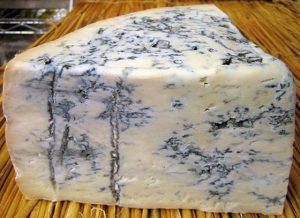 Gorgonzola is a very ancient cheese. Some say Gorgonzola was first produced in the town of Gorgonzola, near Milan, in the year 879 AD; some other say that it was first produced in Pasturo in the province of Lecco, a great cheese-making area for centuries due to the presence of excellent natural caves where the average temperature is constantly between 6°C and 12°C.
Gorgonzola is a very ancient cheese. Some say Gorgonzola was first produced in the town of Gorgonzola, near Milan, in the year 879 AD; some other say that it was first produced in Pasturo in the province of Lecco, a great cheese-making area for centuries due to the presence of excellent natural caves where the average temperature is constantly between 6°C and 12°C.
In any case, the town of Gorgonzola remained the most famous place, although it was not the main production or trade centre for various centuries. In fact, the real Gorgonzola's first name was "stracchino di Gorgonzola", later better defined with the synonym "green stracchino". Since the beginning of the 20th Century, the success of Gorgonzola cheese has been growing, especially abroad: approximately 30% (13,000 tons) is exported. Germany and France are the main consumer countries, absorbing more than 50% of overall export. Switzerland, United Kingdom, The Netherlands, Scandinavian countries, and Spain follow in Europe; then, USA and Canada. Significant signals also come from the Far East and Australia: Japan and China are the countries where Italian cheeses are most successful. In particular, Gorgonzola cheese consumption has grown from a few dozen tons imported until the 1990s to over 400 tons recently.
Only with the G
Gorgonzola rounds are marked at the origin on both flat faces. Consumers may recognise the cheese when they buy it by the G brand printed on the aluminium sheet wrapping the cheese, which is exclusively assigned to the producers authorised by the Consortium.
By law and tradition, Gorgonzola cheese production is allowed in only two Italian regions and only the following provinces: Novara, Vercelli, Cuneo, Biella, Verbano Cusio Ossola, and the area of Casale Monferrato for Piedmont region, and Bergamo, Brescia, Como, Cremona, Lecco, Lodi, Milano, Monza, Pavia, and Varese for Lombardy region. Only milk produced in such provinces may be used to produce and grant Gorgonzola cheese a DOP certification.
Gorgonzola cheese is creamy and soft, with a peculiar, typical taste. Soft gorgonzola cheese is slightly spicy; spicy gorgonzola, whose curd is more blue-veined, is thicker and more crumbly.
Extremely rich in minerals and vitamins, Gorgonzola cheese has a significant content in proteins and a moderate fat content compared with other cheeses. As Gorgonzola cheese is "live" food, whose maturation never ends, it is recommended to buy reasonable quantities that can be consumed within a few days. Spicy Gorgonzola can be preserved longer without changing its characteristics, as compared with soft Gorgonzola.
It should be preserved with care to keep pleasant its aromas and tastes, but always in the fridge. Many people do not keep Gorgonzola in the cheese container, as they are afraid that its typical smell may be transferred to other cheese. A simple recommended solution is to remove the crust and wrap Gorgonzola, without its crust, in aluminium or keep it in special taste-saving containers, if it is purchased in these containers; its crust is often the cause of its penetrating and not always pleasant smell.
Before consumption, it is recommended that you keep Gorgonzola at room temperature for at least 30 minutes so that its organoleptic characteristics are enhanced and its maximum tastiness reached.
 Gorgonzola cheese is good to prepare both simple and complex recipes, and excellent sauces and tasty creams, adding butter or cream, which are ideal for pasta or rice dishes or tasty potato gnocchi. This is also a way to use gorgonzola when it was left in the fridge for too long and its taste is too strong.
Gorgonzola cheese is good to prepare both simple and complex recipes, and excellent sauces and tasty creams, adding butter or cream, which are ideal for pasta or rice dishes or tasty potato gnocchi. This is also a way to use gorgonzola when it was left in the fridge for too long and its taste is too strong.

